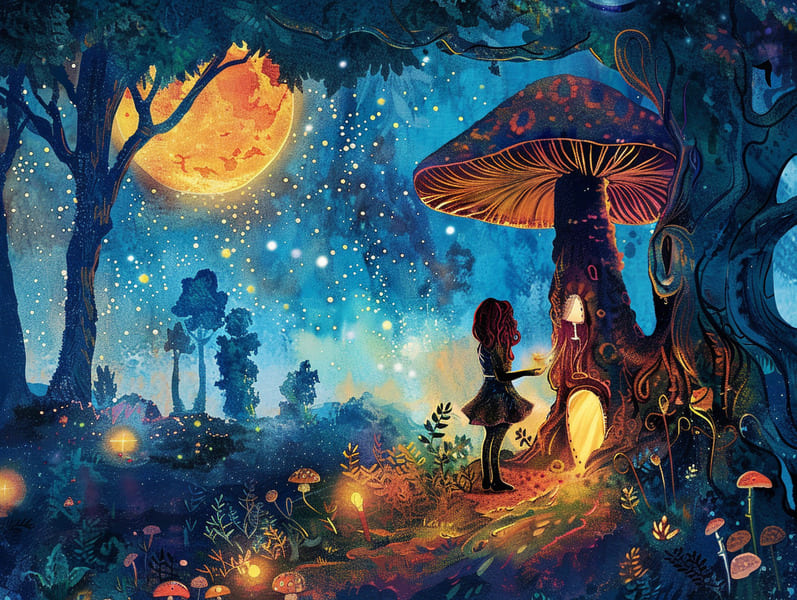
Popular fairy tales have long histories. These tales have been narrated from one generation to the next long before they were ever transcribed. They sprang from a variety of civilizations, including Indigenous traditions. They were initially transmitted among mature audiences, often carrying themes and messages related to the societal norms and beliefs of the time.
The Brothers Grimm, Jacob and Wilhelm, were among the first to collect many of these beloved narratives. Their published works, "Grimm's Fairy Tales," included tales like "The Story of Cinderella," "The Bread Crumb Trail," and "Schneewittchen," which have since become essentials in the world of beloved fairy tales. Similarly, Hans Andersen's fanciful tales, such as "The Sea Maid," and "The Story of the Ugly Duckling," have touched hearts worldwide, securing their place in the pantheon of classic fairy tales.
Even though they are old, traditional fairy tales remain as important as ever, especially as children's bedtime stories. These enchanting tales are now available in numerous formats, including richly illustrated books, fantastical animations, and online storybooks.
Their continued relevance can be ascribed to several magical reasons:
Valuable Lessons: Timeless fairy tales often teach important moral lessons. Narratives like "The Tale of the Boy Who Cried Wolf" teach the merit of being truthful, while "The Hare and the Tortoise" emphasize the traits of resolve and unassuming nature. These narratives offer children clear distinctions between correct and incorrect, shaping their moral compass in a gentle yet significant way.
Warmth and Understanding: Timeless fairy tales frequently present beings facing challenges and problems, motivating listeners to feel with their struggles and encourage their triumphs. For instance, "Beauty and Her Beast" illustrates the merit of seeing beyond looks to perceive the real person of a character, strengthening perception and awareness.
Cultural Insights: Many traditional fairy tales are interwoven with the cultural contexts from which they originated. Exploring these tales can provide captivating looks into different cultures, cultivating a sense of global appreciation and knowledge.
Fantasy and Imagination: The imaginative elements in fairy tales—magical kingdoms—awaken children’s imaginations. These stories take readers to enchanted realms, awakening creative thinking and a sense of excitement that remains a lifetime.
Ancient fairy tales are not only captivating but also educational. They work as delightful tools in fostering various thinking and feeling skills in little ones. When old fairy tales are spoken out loud, they boost language development by presenting new terms and elaborate sentence structures. This practice also improves listening abilities and mental focus, as little ones keep up with the story, looking forward to see what happens next.
Furthermore, exploring the themes and characters of old fairy tales can improve problem-solving abilities and analytical skills. Young ones are led to discern patterns, expect results, and comprehend cause and effect. These discussions also aid young ones convey their thoughts and feelings, cultivating their emotional intelligence.
In today’s digital era, the presence of digital storybooks has made these tales more accessible than ever. Digital sites and digital apps present comprehensive collections of popular fairy tales that can be experienced or listened to anytime, anywhere. Fairy tales read aloud are particularly well-received, making available an entertaining method for the young to delight in these bewitching tales. Audio stories and read-to-me videos bring characters and settings to life, often paired with delightful audio effects and harmonies that enhance the tale experience.
The unending appeal of old fairy tales lies in their ability to modify to modern days while keeping their core messages. Contemporary renditions of these narratives often feature more multicultural figures and modern settings, making them relevant to today’s audience. However, the fundamental themes of valor, humanity, and justice remain unchanged, continuing to affect kids of all ages.
Fairy tales also offer a sense of warmth and knownness. They extend a methodical narrative with a recognizable beginning, middle, and end, often closing with the ending of conflicts and the triumph of justice over injustice. This steadiness can be comforting for the young, yielding a sense of solidity in an always shifting world.
Ancient fairy tales continue to captivate and guide new generations, maintaining their captivation and importance in modern society. As nighttime stories for kids, they yield a perfect blend of charm and understanding, encouraging moral values, empathy, and creativity. The abundance of online storybooks and the well-liked nature of fairy tales voiced validate that these timeless fairy tales remain reachable to new generations.
By keeping and communicating these stories, we find it here continue to value the rich tapestry of storytelling and cultural heritage. Whether you are browsing a beautifully illustrated book, perusing a digital collection, or hearing an audio story, the loveliness of bedtime fairy tales is always within reach. These stories highlight of the ageless ability of narratives and its ability to connect us across generations and cultures.
Whether you are enjoying a gorgeously illustrated book, seeing a web collection, or listening on an sound book, the beauty of classic fairy tales is always within reach.
These stories teach us of the timeless influence of narratives and its ability to bond us across eras and regions, forming a connection that delights and instructs alike.